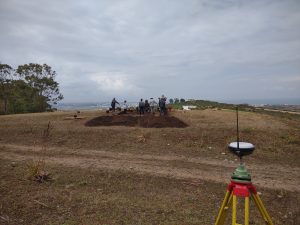2023 Season, Gardens of the Hesperides: The Rural Archaeology of the Loukkos Valley

Stephen Collins-Elliott Reports
This June marked the last summer season of fieldwork of the joint Moroccan-American archaeological project, Gardens of the Hesperides: The Rural Archaeology of the Loukkos Valley, a collaboration between the University of Tennessee, Knoxville, and the Institut National des Sciences de l’Archéologie et du Patriomoine. Co-directed by Aomar Akerraz (INSAP) and Stephen Collins-Elliott (UT), this project had the aim of surveying and excavating the countryside around Lixus, the earliest city in northwestern Africa, to determine the impact of Roman annexation on the local economy.
From May 22 to June 23, 2023, UT Department of Classics students Tony Caldwell, Landon Bryan, and Mike McCann worked as part of an international team of Moroccan, American, and British archaeologists excavating two small rural sites, HESP51/LA21, located to the east of the sanctuary of Sidi Khayri, and HESP23/LA43, Koudiat Hmamou, located to the south of Sidi Kharyi, on the north side of the Loukkos river. Project staff this summer included Layla Es-Sadra (Mohamed V University, Rabat), Katelin McCullough (Hollins University), Katie Tardio (Bucknell University), Jonathan Lester (Cambridge Archaeology), Caroline Pope (Vanderbilt University), Chris Jazwa, and Kaitlyn Stiles (University of Nevada at Reno). Other undergraduate and graduate students from the Universities of Michigan, Minnesota, and Nevada at Reno also participated.

The project accomplished its goals in uncovering the phases of occupation at these two rural sites, which emerged in the late first century BCE, showing evidence of rural intensification prior to the arrival of the Roman military and administration, which aligned with the results of the two previous seasons of fieldwork. The team looks forward to finishing the publication of Project Hesperides. Stephen Collins-Elliott plans to excavate in the Lixus area next summer, in a prospective project focusing both on Lixus itself and on the surrounding countryside, comparing the development of the city and countryside in the pre-Roman period.
Project Hesperides expresses its thanks for the support of the Institut National des Sciences de l’Archéologie et du Patriomoine, the Ministry of Culture of the Kingdom of Morocco, the UT Department of Classics, UT College of Arts & Sciences, UT Office of Research, Innovation & Economic Development, the Loeb Classical Library Foundation, the National Endowment for the Humanities and the Archaeological Institute of America, the Marco Institute for Medieval and Renaissance Studies, and the University of Nevada at Reno.
Student Experiences
Tony Caldwell:
I had the honor this summer to participate in archaeological fieldwork with Professor Collins-Elliott and his colleagues on the Hesperides Project. Each moment spent in the field was valuable to me as a student in archaeology. I was introduced to GIS systems, archaeological methodology, and local Roman terracotta morphology, and met professional archaeologists working in their various specialized fields. While in Morocco, I was introduced to new languages and cultures. We had the opportunity to see multiple archaeological sites, such as Lixus and Volubilis, and witness their respective finds in the local museums. I was able to make connections with other students on the trip as well as professionals contributing to the Hesperides Project. I now have lifelong friends who will one day be colleagues. I also have gained experience in the field as well as a newfound respect for the process of fieldwork altogether. This experience was beyond valuable to me as a student. One of the most important revelations during my participation this summer revolved around my enjoyment in the field. Each aspect of the work was enjoyable, from cleaning pot sherds, to discovering something ancient in the compacted dirt. I would highly recommend any student interested in archaeology to pursue field work on this project. I’d like to give my great thanks to the scholarship committee of UT’s Department of Classics and the Haines-Morris travel scholarship, as well as to those who participated in the Gardens of the Hesperides: The Rural Archaeology of the Loukkos Valley project.
Landon Bryan:
Adventure. Heat. Neck tans. These are all things that could describe the lives of an archaeologist. When I joined the Gardens of the Hesperides project, I did not know what to expect. This was my first fieldwork experience and my first time being out of the country, so it was a new experience for me all around. I learned many valuable things over the course of my journey in Morocco: excavation principles, laboratory etiquette, GIS systems, and that Moroccan Sprite is leagues above any found here in America. I also had the great opportunity of making lifelong connections with other students and professionals in the field. I would like to thank Dr. Stephen Collins-Elliott for the opportunity and the Department of Classics for the Haines-Morris scholarship, which made it possible for me to take part in this memorable trip.
Mike McCann:
Digging in Morocco was an experience unparalleled to anything in my life previously. I had the privilege of going on an expedition with people who have the same niche interests and curiosities, and the opportunity to discover and discuss ideas with them. Digging in North Africa was a nearly transcendent experience, with beautiful beaches and hills in a full 360 degrees around you and in the distance. Unearthing the sites of ancient civilizations for the first time since they had been covered is a feeling that cannot be replicated or simulated in an academic or digital setting. We alone had the opportunity to learn more about these sites and possibly impact the world of archaeology itself. On our off days, we were very generously given trips to cities across the country, from Tangier near the strait of Gibraltar to the capital, Rabat. In these cities, we toured other attractions, museums, natural formations, ancient sites, and the modern shops and restaurants that sprawl around them. College is the prime time of your life to have this experience and it may even help you to make archaeology a life-long profession.